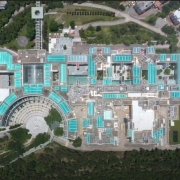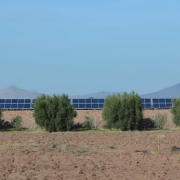Doubling renewables can save up to USD 4.2 trillion annually by 2030, IRENA says
Doubling the share of renewables in the global energy mix by 2030 can save up to USD 4.2 trillion annually by 2030, according to a new report by the International Renewable Energy Agency (IRENA). Savings would be up to 15 times higher than costs, thanks to avoided expenditures on air pollution and climate change.
REmap: Roadmap for a Renewable Energy Future, released yesterday at the Berlin Energy Transition Dialogue event, recommends options to boost the share of renewable energy in the global energy mix from just over 18 per cent today, to as much as 36 per cent by 2030.
IRENA Director-General Adnan Z. Amin:
“Achieving a doubling is not only feasible, it is cheaper than not doing so. REmap shows this is not only the most economic pathway, but also the most socially and environmentally conscious. It would create more jobs, save millions of lives from reduced air pollution and set us on a pathway to limit global temperature rise to two degrees as agreed in Paris.”
This second edition of IRENA’s global roadmap broadens its analysis to cover 40 countries, representing 80 per cent of global energy use. According to the report, great strides have been made to increase renewables in the power sector, which is on track to generate roughly 30 per cent of the world’s electricity by 2030 (up from 23 per cent today). If a doubling is achieved, this share would grow to more than 50 per cent. There is also great potential to increase renewables in transport, buildings and industry, but these sectors are currently lagging behind.
Director of IRENA’s Innovation and Technology Centre Dolf Gielen said:
“The energy transition is well underway in the power sector, but to reach global climate and development targets, the next phase will require more focus on transport, heating and cooling. If a doubling is achieved, these sectors would account for roughly half of renewable energy use in 2030 and so must scale-up dramatically to meet that target.”
Under existing national plans, the global renewables share would only reach 21 per cent by 2030. To achieve a doubling, the annual rate of renewable energy deployment would need to increase six-fold and would require an average annual investment of USD 770 billion up to 2030. Achieving this would increase the cost of the global energy system by roughly USD 290 billion per year in 2030, but the savings achieved through this doubling – thanks to avoided expenditures on air pollution and climate change – are up to 15 times higher than this cost.
Some of the key findings:
- Doubling of the renewable share in global energy use by 2030, compared with today’s levels, would result in significant savings to society. It would also boost economic growth and employment.
- The renewable energy share must increase by 1 percentage points annually up to 2030 as a worldwide average. The current growth rate is just 0.17 percentage points per year, meaning a six-fold increase is necessary to realise a doubling.
- Together with efficiency solutions that slow down demand growth, the renewable-energy technologies identified in this analysis can boost the global share for renewables to 30% by 2030. Without those options, the renewable share would rise just 3 percentage points by 2030, to 21%.
- Doubling Options – or stronger additional actions – could close the gap to 36% through electrification of industry, buildings and transport; by coupling power generation with heat and transport where possible; and with strategies such as early retirement for non-renewable energy power plants.
- Global leaders can limit global temperature rises to 2 degrees Celsius, but reaching the ideal target of 1.5 degrees Celsius requires more than a doubling of the renewable share.
- Depending on the degree to which the renewable energy share increases, up to 12 gigatonnes of energy-related carbon dioxide emissions can be eliminated beyond the Reference Case.
- Despite falling prices of fossil fuels, investments in renewable energy continue to increase: 2015 was a record year for solar photovoltaic and wind power installations.
Solar PV identified as a mainstream technology
The report also highlights that the new Reference Case for 2016 contains important improvements over the 2014 edition of REmap, with governments adopting more ambitious plans for renewables overall. The difference in total renewable energy capacity between the two editions is about 500 GW for the year 2030. The most notable change is for solar PV (dominated by developments in India and China). The projected capacity in 2030 is about 340 GW higher; at 780 GW compared with 440 GW in 2014. This is an increase of more than 70%, mainly explained by the improved economics of solar PV, which indicate that it is now a mainstream technology considered by all countries in their national plans.
Mr. Amin said:
“The age of renewable energy is here, but without concerted efforts, its potential will not be reached fast enough to meet international climate and development targets. For decision makers in the public and private sectors alike, this roadmap sends an alert – both on the opportunities at hand and on the costs of not taking them.”
Experts discuss REmap: Roadmap for a Renewable Energy Future
For more information see the presentation below or download the full report here.
Source: Press Relase by International Renewable Energy Agency (IRENA). Image Credit: IRENA.











